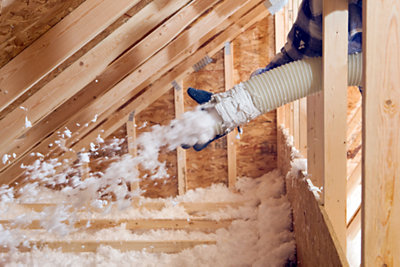Your Easy Guide to Better Home Insulation
In 2021, homeowners in Arizona paid around $10 per month more for electricity than the average U.S. household.
In a climate with scorching hot temperatures, it's nearly impossible to live without a heating and cooling system. That doesn't mean you have to break the bank to stay comfortable.
One way you can optimize heating and cooling in your home is to make sure you have good insulation. Tame the Arizona heat from the inside out with a well-insulated home.
Read our brief guide that covers how to better insulate your home. Whether you need to insulate the attic, exterior walls, or your doors and windows, our guide has you covered.
Why Insulation Matters
Insulation acts as a barrier against the searing outdoor heat. Not only does it prevent warm air from infiltrating your home, but insulation also helps keep the conditioned air from escaping.
What about those chilly desert mornings and nights?
There's no reason you should feel cold air in your home unless it's coming from your AC. Insulation prevents your home from losing heat. It helps keep your home cozy regardless of the season.
By investing in better insulation, you can significantly reduce air conditioning costs. According to the Energy Star program, improving your insulation (and air sealing your home) could save you 15% on your energy bills.
Key Areas Where You Can Improve Insulation
Start by checking your home for drafts around doors and windows. Gaps allow hot air to seep indoors. Also, inspect your attic for potential heat intrusion.
During the summer, your attic can turn into an oven if not adequately insulated. This raises the indoor temperature in the rest of your home.
Basements and crawl spaces are rare in Southern Arizona. If your home has one, poor insulation can allow hot air to rise into your living spaces. When this happens, it compounds the heat issue.
Exterior walls are another important area to examine. Insufficient insulation in walls can lead to heat penetration. This makes it challenging to maintain comfortable indoor temperatures.
By sealing and insulating these areas, you can combat the Arizona heat and make your home more energy efficient.
Insulating the Attic
In Arizona, an insulated attic is your primary line of defense against the relentless sun. Proper attic insulation blocks radiant heat from penetrating your living space.
After adding attic insulation, you should notice less difficulty keeping indoor temperatures cooler.
Opt for reflective insulation or radiant barriers to minimize heat transfer from the roof to the attic. Consider using spray foam insulation to seal any gaps or cracks.
With intense desert heat, make sure you have good ventilation in the attic. Adequate airflow will prevent the space from becoming a hotbox.
Insulation and ventilation work hand in hand. Together, they help keep your home cool and comfortable, even during the hottest days.
Should you insulate your attic floor? Unless you plan to use your attic as a living space, the best thing you can do to help keep your home comfortable is install insulation on the attic floor.
If you ask a professional, they'll most likely tell you the best way to insulate an attic floor is with loose-fill insulation, a.k.a. blown-in insulation.
More About Loose-Fill Insulation
Homeowners and professional insulation installers love loose-fill materials for several reasons.
Protecting the environment is one reason. Loose-fill insulation reduces the impact on the environment. One popular material, cellulose insulation, consists of recycled paper products.
Manufacturers use materials from the trash like newsprint, cardboard, and paperboard. They treat the materials for fire resistance, making them safer for your home.
If you choose loose-fill fiberglass insulation, those products contain recycled fiberglass.
Installers prefer loose-fill materials because the installation process is simple. Two installers, a long piece of tubing, and an industrial blower are all it takes to complete the job.
The entire process only takes a few hours rather than a few days.
Exterior Walls Hold Heat Too
Shield your home from the blazing sun by insulating your exterior walls. In hot climates like Arizona, selecting suitable insulation materials plays a significant role in keeping indoor temperatures stable.
One innovative product that's growing in popularity is foam board insulation. Also called rigid foam, you can use this insulation product just about anywhere in your home.
Foam board insulation comes in several different R-values. Here in Arizona, we recommend R-values of R38 (14") and R60 (22") for better thermal resistance.
If you have a basement or crawl space, consider insulating with foam board insulation. It's moisture and pest-resistant - two features required in damp spaces.
Insulating Doors and Windows
Your doors and windows act as gateways to the hot Arizona air. For maximum indoor comfort, don't skim on insulation.
Before adding new insulation, use weather stripping around doors and windows. This creates a tight seal, which prevents drafts from entering your home. Caulk any gaps or cracks in window frames to enhance insulation further.
If you're considering upgrading windows, now may be the time. Combining new energy-efficient windows with an insulation upgrade can help you save money.
If you decide to limit the project to adding insulation to doors and windows, you'll still benefit.
With the right insulation, you can create a comfortable indoor environment. Insulation will help reduce your need to rely on excessive use of your cooling system.
What About Insulating Electrical Outlets?
How much hot air can get in through an electrical outlet?
If you remove an outlet, you may notice small gaps in the area around the outlet. These gaps allow air to leak in and out, leading to energy loss and discomfort.
The solution is relatively simple.
Insulation installers can use outlet gaskets or foam insulation pads. Outlet gaskets create a tight seal between the outlet box and the cover plate, minimizing air leakage.
Outlet gaskets are inexpensive and easy to install.
Use foam insulation pads for an easy solution to air leaks. Place the pads inside the outlet cover and switch plates. Pre-cut in the shape of an outlet and switch openings, these pads are also a cinch to install.
By insulating the area around electrical outlets, you can contribute to a more energy-efficient home. This will reduce the strain on your heating and cooling systems and save on energy costs.
DIY vs. Professional Insulation Services
If you're thinking about how to better insulate your home, you have the choice of DIY or seeking professional assistance. There are several reasons why it may be beneficial to work with a professional insulation installer.
Safety Concerns
Insulation materials can be hazardous if not handled properly. Fiberglass and spray foam can irritate the skin, eyes, and respiratory system. Professional insulation contractors have the expertise to handle insulation materials safely.
Proper Installation
Insulation needs to be installed correctly to be effective. Incorrect installations can lead to gaps, voids, and insufficient coverage. You risk reducing the insulation's performance and compromising your home's energy efficiency.
Knowledge of Building Codes
Building codes and regulations often dictate specific insulation requirements. Professional contractors are familiar with local building codes. They will ensure that your insulation project meets all necessary standards.
Specialized Equipment
Some installation methods (such as blown-in insulation) require specialized equipment. Professional installers have access to the right tools to complete the job.
Comprehensive Assessment
Professionals can conduct an energy audit. Audits identify specific areas where your home needs insulation. Installers can then tailor the project to your home's unique needs.
Some insulation tasks, like weather-stripping and sealing gaps, can make excellent DIY projects. Larger and more complex insulation jobs are usually best left to professionals.
Let Us Show You How to Better Insulate Your Home
You're now equipped to transform your Arizona home into a cool, energy-efficient oasis. By knowing how to better insulate your home, you'll experience comfort even in the face of the blazing sun.
Since 1974, the team at Parker & Sons has helped home and business owners in the Phoenix and Tucson areas. We specialize in cooling, heating, plumbing, and electrical services.
We're excited to help you enjoy the benefits of better insulation. Those benefits include reduced energy consumption and energy savings. Reach out today to schedule an appointment.
Related Reading
Subscribe to our e-Newsletter
Stay up-to-date on current news, promotions, and industry tips.

